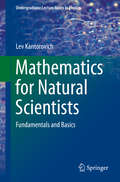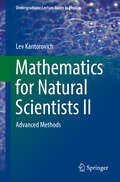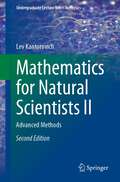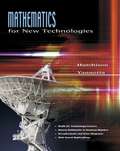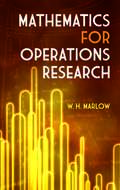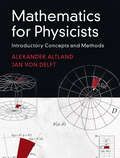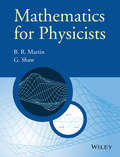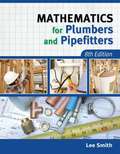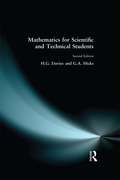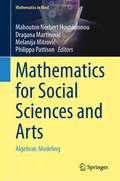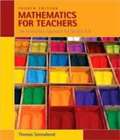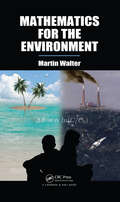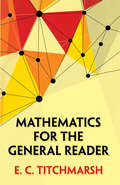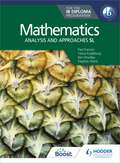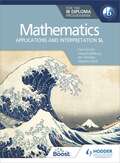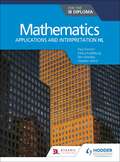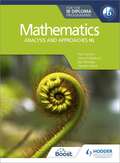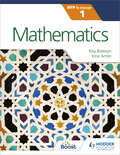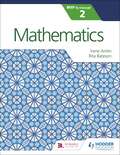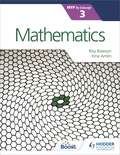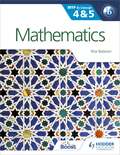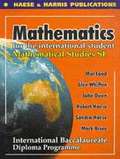- Table View
- List View
Mathematics for Natural Scientists
by Lev KantorovichThis book covers a course of mathematics designed primarily for physics and engineering students. It includes all the essential material on mathematical methods, presented in a form accessible to physics students, avoiding precise mathematical jargon and proofs which are comprehensible only to mathematicians. Instead, all proofs are given in a form that is clear and convincing enough for a physicist. Examples, where appropriate, are given from physics contexts. Both solved and unsolved problems are provided in each section of the book. Mathematics for Natural Scientists: Fundamentals and Basics is the first of two volumes. Advanced topics and their applications in physics are covered in the second volume.
Mathematics for Natural Scientists II
by Lev KantorovichThis book covers the advanced mathematical techniques useful for physics and engineering students, presented in a form accessible to physics students, avoiding precise mathematical jargon and laborious proofs. Instead, all proofs are given in a simplified form that is clear and convincing for a physicist. Examples, where appropriate, are given from physics contexts. Both solved and unsolved problems are provided in each chapter. Mathematics for Natural Scientists II: Advanced Methods is the second of two volumes. It follows the first volume on Fundamentals and Basics.
Mathematics for Natural Scientists II: Advanced Methods (Undergraduate Lecture Notes in Physics)
by Lev KantorovichThis textbook, the second in a series (the first covered fundamentals and basics), seeks to make its material accessible to physics students. Physics/engineering can be greatly enhanced by knowledge of advanced mathematical techniques, but the math-specific jargon and laborious proofs can be off-putting to students not well versed in abstract math. This book uses examples and proofs designed to be clear and convincing from the context of physics, as well as providing a large number of both solved and unsolved problems in each chapter. This is the second edition, and it has been significantly revised and enlarged, with Chapters 1 (on linear algebra) and 2 (on the calculus of complex numbers and functions) having been particularly expanded. The enhanced topics throughout the book include: vector spaces, general (non-Hermitian, including normal and defective) matrices and their right/left eigenvectors/values, Jordan form, pseudoinverse, linearsystems of differential equations, Gaussian elimination, fundamental theorem of algebra, convergence of a Fourie series and Gibbs-Wilbraham phenomenon, careful derivation of the Fourier integral and of the inverse Laplace transform. New material has been added on many physics topics meant to illustrate the maths, such as 3D rotation, properties of the free electron gas, van Hove singularities, and methods for both solving PDEs with a Fourier transform and calculating the width of a domain wall in a ferromagnet, to mention just a few. This textbook should prove invaluable to all of those with an interest in physics/engineering who have previously experienced difficulty processing the math involved.
Mathematics for New Technologies
by Don Hutchison Mark YannottaThis text addresses the need for a new mathematics text for careers using digital technology. The material is brought to life through several applications including the mathematics of screen and printer displays. The course, which covers binary arithmetic to Boolean algebra, is emerging throughout the country and may fill a need at your school. This unique text teaches topics such as binary fractions, hexadecimal numbers, and Venn diagrams to students with only a beginning algebra background.
Mathematics for Operations Research
by W. H. MarlowThis practical, applications-oriented text demonstrates the key role of mathematics in optimization and linear systems. It explains effective procedures for performing mathematical tasks that arise in many fields, including operations research, engineering, systems sciences, statistics, and economics. Readers will learn how to resolve linear independence and find null spaces and factors of matrices, determine existence of restricted solutions to linear equations and inequalities, and resolve definiteness of Hermitian and real symmetric matrices by Gaussian pivoting. Additional topics include how to diagonalize — or "nearly" diagonalize — square matrices, differentiate vectors and matrices by the chain rule, solve systems of differential and difference equations, and other subjects. Most of the examples and many of the 1,300 problems illustrate techniques, and nearly all of the tables display reference material for procedures. Differential and integral calculus are prerequisites.
Mathematics for Physicists: Introductory Concepts and Methods
by Alexander Altland Jan Von DelftThis textbook is a comprehensive introduction to the key disciplines of mathematics - linear algebra, calculus, and geometry - needed in the undergraduate physics curriculum. Its leitmotiv is that success in learning these subjects depends on a good balance between theory and practice. Reflecting this belief, mathematical foundations are explained in pedagogical depth, and computational methods are introduced from a physicist's perspective and in a timely manner. This original approach presents concepts and methods as inseparable entities, facilitating in-depth understanding and making even advanced mathematics tangible. The book guides the reader from high-school level to advanced subjects such as tensor algebra, complex functions, and differential geometry. It contains numerous worked examples, info sections providing context, biographical boxes, several detailed case studies, over 300 problems, and fully worked solutions for all odd-numbered problems. An online solutions manual for all even-numbered problems will be made available to instructors.
Mathematics for Physicists
by Brian R. Martin Graham P. ShawMathematics for Physicists is a relatively short volume covering all the essential mathematics needed for a typical first degree in physics, from a starting point that is compatible with modern school mathematics syllabuses. Early chapters deliberately overlap with senior school mathematics, to a degree that will depend on the background of the individual reader, who may quickly skip over those topics with which he or she is already familiar. The rest of the book covers the mathematics that is usually compulsory for all students in their first two years of a typical university physics degree, plus a little more. There are worked examples throughout the text, and chapter-end problem sets. Mathematics for Physicists features: Interfaces with modern school mathematics syllabuses All topics usually taught in the first two years of a physics degree Worked examples throughout Problems in every chapter, with answers to selected questions at the end of the book and full solutions on a website This text will be an excellent resource for undergraduate students in physics and a quick reference guide for more advanced students, as well as being appropriate for students in other physical sciences, such as astronomy, chemistry and earth sciences.
Mathematics for Physics
by Michael Stone Paul GoldbartAn engagingly-written account of mathematical tools and ideas, this book provides a graduate-level introduction to the mathematics used in research in physics. The first half of the book focuses on the traditional mathematical methods of physics - differential and integral equations, Fourier series and the calculus of variations. The second half contains an introduction to more advanced subjects, including differential geometry, topology and complex variables. The authors' exposition avoids excess rigor whilst explaining subtle but important points often glossed over in more elementary texts. The topics are illustrated at every stage by carefully chosen examples, exercises and problems drawn from realistic physics settings. These make it useful both as a textbook in advanced courses and for self-study.
Mathematics for Plumbers and Pipefitters
by Lee SmithNow in its 8th edition, MATHEMATICS FOR PLUMBERS AND PIPEFITTERS delivers the essential math skills necessary in the plumbing and pipefitting professions. Starting with a thorough math review to ensure a solid foundation, the book progresses into specific on-the-job applications, such as pipe length calculations, sheet metal work, and the builder's level. Broad-based subjects like physics, volume, pressures, and capacities round out your knowledge, while a new chapter on the business of plumbing invites you to consider an exciting entrepreneurial venture. Written by a Master Plumber and experienced vocational educator, MATHEMATICS FOR PLUMBERS AND PIPEFITTERS, 8th Edition includes a multitude of real-world examples, reference tables, and formulas to help you build a rewarding career in the plumbing and pipefitting trade.
Mathematics for Scientific and Technical Students
by H. Davies H. G. Davies G. A. HicksThis new edition provides a full introduction to the mathematics required for all technical subjects, particularly engineering. It has been completely updated and is designed to bring the student up to the required mathematical knowledge for their course.
Mathematics for Social Sciences and Arts: Algebraic Modeling (Mathematics in Mind)
by Mahouton Norbert Hounkonnou Dragana Martinovic Melanija Mitrović Philippa PattisonThis book addresses interconnections between contemporary advances in mathematics, especially algebra, with applications in the social sciences and the arts. It promotes the idea that knowledge cannot remain in disciplinary silos, rather, it belongs to all people, and is dedicated to associative relationships in a variety of mathematics applications, from sociology to linguistics, including anthropology, semiotics, education, and cognitive science. Contributions illuminate some of the ways in which algebra is developed, learned, understood, communicated, and applied in the social sciences and the humanities.The content in this book has its origins in a conference, Mathematics for Social Sciences and Arts–Algebraic Modelling, virtually hosted by the Faculty of Mechanical Engineering, University of Niš, Serbia, from the 24th to the 26th of May, 2021. This conference brought together scholars from various disciplines and geographic regions and focused on the juxtaposition of algebra and social science applications. The conference organizers, higher education institutes from four different continents, invited leading scientists in social sciences and algebra, to contribute to this volume.The first part of this book addresses algebraic and mathematical thinking, specifically learning and practicing mathematics from a cognitive science perspective, as well as illustrative applications to distinctly human concerns, like education and semiotics. The second part focuses on algebraic semigroups and some of their generalizations. This book and the conference that engendered it provide an example of a fruitful collaboration, in which the skills and deep knowledge of algebraic structures, modeling, social sciences and arts brought in by the authors from different countries and continents merge in harmonious ways. These expositions are a rich resource and are of interest both to mathematicians and non-mathematicians.
Mathematics for Teachers: An Interactive Approach for Grade K-8
by Thomas SonnabendMathematics for Teachers: An Interactive Approach for Grades K-8 actively involves students in developing and explaining mathematical concepts and how the topics relate to NCTM Standards and Curriculum focal points. The text includes coverage of reasoning, sets, arithmetic, geometry, measurement, algebra, statistics, and probability. The carefully organized, interactive lesson format promotes student involvement and gradually leads the student to a deeper understanding of mathematical ideas.
Mathematics for the Environment
by Martin WalterMathematics for the Environment shows how to employ simple mathematical tools, such as arithmetic, to uncover fundamental conflicts between the logic of human civilization and the logic of Nature. These tools can then be used to understand and effectively deal with economic, environmental, and social issues. With elementary mathematics, the book se
Mathematics for the General Reader (Dover Books on Mathematics)
by E. C. TitchmarshThis highly accessible introduction to mathematics is geared toward readers seeking a firm grasp of the essentials of mathematical theory and practice. The treatment also offers a concise outline of mathematical history and a clearer notion of why mathematicians do what they do.Author E. C. Titchmarsh, who served for many years as Savilian Professor of Geometry at Oxford University, begins with counting and the fundamentals of arithmetic. He guides readers through the complexities of algebra, fractions, geometry, irrational numbers, logarithms, infinite series, complex numbers, quadratic equations, trigonometry, functions, and integral and differential calculus. Titchmarsh's graceful, fluid style helps make complicated topics easier to grasp, and his inclusion of numerous examples will prove especially helpful to readers with little or no background in mathematics.
Mathematics for the IB Diploma: Analysis and approaches SL
by Paul Fannon Stephen Ward Ben Woolley Vesna Kadelburg Huw JonesDeveloped in cooperation with the International Baccalaureate®Enable students to construct, communicate and justify correct mathematical arguments, with a range of activities and examples of maths in the real world.- Engage and excite students with examples and photos of maths in the real world, plus inquisitive starter activities to encourage their problem-solving skills- Build mathematical thinking with our 'Toolkit' and mathematical exploration chapter, along with our new toolkit feature of questions, investigations and activities- Develop understanding with key concepts and applications integrated throughout, along with TOK links for every topic- Prepare your students for assessment with worked examples, and extended essay support- Check understanding with review exercise midway and at the end of the coursebookFollows the new 2019 IB Guide for Mathematics: analysis and approaches Standard LevelAvailable in the seriesMathematics for the IB Diploma: Analysis and approaches SLStudent Book ISBN: 9781510462359Student Book Boost eBook ISBN: 9781398334304Exam Practice Workbook Mathematics for the IB Diploma: Analysis and approaches SL 9781398321182Exam Practice Workbook Mathematics for the IB Diploma: Analysis and approaches SL Boost eBook 9781398342316Mathematics for the IB Diploma: Analysis and approaches HLStudent Book ISBN: 9781510462366Student Book Boost eBook ISBN: 9781398334311Exam Practice Workbook Mathematics for the IB Diploma: Analysis and approaches HL 9781398321878Exam Practice Workbook Mathematics for the IB Diploma: Analysis and approaches HL Boost eBook 9781398342361SL & HL Boost Subscription: 9781398341265
Mathematics for the IB Diploma: Applications and interpretation SL
by Stephen Ward Paul Fannon Vesna Kadelburg Ben WoolleyEnable students to construct mathematical models by exploring challenging problems and the use of technology. - Engage and excite students with examples and photos of maths in the real world, plus inquisitive starter activities to encourage their problem-solving skills. - Build mathematical thinking with our 'Toolkit' and mathematical exploration chapter, along with our new toolkit feature of questions, investigations and activities. - Develop understanding with key concepts and applications integrated throughout, along with TOK links for every topic. - Prepare your students for assessment with worked examples, extended essay support and colour-coded questions to highlight the level of difficulty and the different types of questions. - Check understanding with review exercise midway and at the end of the textbook. Follows the new 2019 IB Guide for Mathematics: applications and interpretation Standard Level
Mathematics for the IB Diploma: Applications and interpretation HL
by Stephen Ward Huw Jones Paul Fannon Vesna Kadelburg Ben WoolleyEnable students to construct mathematical models by exploring challenging problems and the use of technology. - Engage and excite students with examples and photos of maths in the real world, plus inquisitive starter activities to encourage their problem-solving skills. - Build mathematical thinking with our 'Toolkit' and mathematical exploration chapter, along with our new toolkit feature of questions, investigations and activities. - Develop understanding with key concepts and applications integrated throughout, along with TOK links for every topic. - Prepare your students for assessment with worked examples, extended essay support and colour-coded questions to highlight the level of difficulty and the different types of questions. - Check understanding with review exercise at the end of the textbook. Follows the new 2019 IB Guide for Mathematics: applications and interpretation Higher LevelAvailable in the seriesMathematics for the IB Diploma: Analysis and approaches SLStudent Book ISBN: 9781510462359 Student eTextbook ISBN: 9781510461895 Whiteboard eTextbook ISBN: 9781510461901 Mathematics for the IB Diploma: Analysis and approaches HLStudent Book ISBN: 9781510462366 Student eTextbook ISBN: 9781510461857 Whiteboard eTextbook ISBN: 9781510461864 SL & HL Teaching & Learning Resources ISBN: 9781510461918 Mathematics for the IB Diploma: Applications and interpretation SLStudent Book ISBN: 9781510462380 Student eTextbook ISBN: 9781510461994 Whiteboard eTextbook ISBN: 9781510462007 Mathematics for the IB Diploma: Applications and interpretation HLStudent Book ISBN: 9781510462373 Student eTextbook ISBN: 9781510461956 Whiteboard eTextbook ISBN: 9781510461963 SL and HL Teaching & Learning Resources ISBN: 9781510462014 Dynamic learning packages (include Teaching & Learning resources and Whiteboard eTextbooks)Analysis & approaches SL & HL ISBN: 9781510461925Applications and interpretation SL and HL ISBN: 9781510462021 Analysis & approaches SL & HL and Applications and interpretation SL and HL ISBN: 9781510468474
Mathematics for the IB Diploma: Analysis and approaches HL
by Paul Fannon Vesna Kadelburg Ben Woolley Stephen Ward Huw JonesEnable students to construct, communicate and justify correct mathematical arguments with a range of activities and examples of maths in the real world.- Engage and excite students with examples and photos of maths in the real world, plus inquisitive starter activities to encourage their problem-solving skills- Build mathematical thinking with our 'Toolkit' and mathematical exploration chapter, along with our new toolkit feature of questions, investigations and activities- Develop understanding with key concepts and applications integrated throughout, along with TOK links for every topic- Prepare your students for assessment with worked examples, and extended essay support- Check understanding with review exercise midway and at the end of the coursebookFollows the new 2019 IB Guide for Mathematics: analysis and approaches Higher Level
Mathematics for the IB MYP 1
by Rita Bateson Irina AmlinA concept-driven and assessment-focused approach to Mathematics teaching and learning.- Approaches each chapter with statements of inquiry framed by key and related concepts, set in a global context- Supports every aspect of assessment using tasks designed by an experienced MYP educator- Differentiates and extends learning with research projects and interdisciplinary opportunities- Applies global contexts in meaningful ways to offer an MYP Mathematics programme with an internationally-minded perspective
Mathematics for the IB MYP 2
by Rita Bateson Irina AmlinA concept-driven and assessment-focused approach to Mathematics teaching and learning.- Approaches each chapter with statements of inquiry framed by key and related concepts, set in a global context- Supports every aspect of assessment using tasks designed by an experienced MYP educator- Differentiates and extends learning with research projects and interdisciplinary opportunities- Applies global contexts in meaningful ways to offer an MYP Mathematics programme with an internationally-minded perspectiv
Mathematics for the IB MYP 3
by Rita Bateson Irina AmlinA concept-driven and assessment-focused approach to Mathematics teaching and learning.- Approaches each chapter with statements of inquiry framed by key and related concepts, set in a global context- Supports every aspect of assessment using tasks designed by an experienced MYP educator- Differentiates and extends learning with research projects and interdisciplinary opportunities- Applies global contexts in meaningful ways to offer an MYP Mathematics programme with an internationally-minded perspective
Mathematics for the IB MYP 3
by Rita Bateson Irina AmlinA concept-driven and assessment-focused approach to Mathematics teaching and learning.- Approaches each chapter with statements of inquiry framed by key and related concepts, set in a global context- Supports every aspect of assessment using tasks designed by an experienced MYP educator- Differentiates and extends learning with research projects and interdisciplinary opportunities- Applies global contexts in meaningful ways to offer an MYP Mathematics programme with an internationally-minded perspective
Mathematics for the IB MYP 4 & 5: By Concept
by Rita BatesonThe only series for MYP 4 and 5 developed exclusively with the IBDrive meaningful inquiry through a unique concept-driven narrative.- Supports every aspect of assessment with opportunities that use the criteria- Gives you easy ways to differentiate and extend learning- Provides a meaningful approach by integrating the inquiry statement in a global context- Develops critical-thinking skills with activities and summative sections rooted in the ATL frameworkFeel confident that you cover the whole framework with standard and extended mathematics included - and Extended clearly signposted.This title is also available in two digital formats via Dynamic Learning. Find out more by clicking on the links at the top of the page.A proof of the first 6 Chapters of the book is now available as an eInspection copy, by clicking the eInspection copy button to the left. Rita Bateson was, until very recently, the Curriculum Manager for MYP Mathematics and Sciences at the International Baccalaureate® (IB) and continues to be involved in curriculum review. She is an experienced teacher of MYP and DP Mathematics and Sciences, and is Head of Mathematics in her current school. She has taught in many international schools in Europe as well as North America. Her interest include overcoming mathematics anxiety in pupils and STEM education. She is also the co-author of MYP by Concept 1-3 Mathematics, with Irina Amlin.
Mathematics for the IB MYP 4 & 5: By Concept (MYP By Concept)
by Rita BatesonExam Board: IBLevel: MYPSubject: MathematicsFirst Teaching: September 2016First Exam: June 2017The only series for MYP 4 and 5 developed in cooperation with the International Baccalaureate (IB)Develop your skills to become an inquiring learner; ensure you navigate the MYP framework with confidence using a concept-driven and assessment-focused approach to Mathematics presented in global contexts.- Develop conceptual understanding with key MYP concepts and related concepts at the heart of each chapter.- Learn by asking questions with a statement of inquiry in each chapter. - Prepare for every aspect of assessment using support and tasks designed by experienced educators.- Understand how to extend your learning through research projects and interdisciplinary opportunities.Feel confident that you cover the whole framework with standard and extended mathematics included - and Extended clearly signposted.This title is also available in two digital formats via Dynamic Learning. Find out more by clicking on the links at the top of the page.A proof of the first 6 Chapters of the book is now available as an eInspection copy, by clicking the eInspection copy button to the left. Rita Bateson was, until very recently, the Curriculum Manager for MYP Mathematics and Sciences at the International Baccalaureate® (IB) and continues to be involved in curriculum review. She is an experienced teacher of MYP and DP Mathematics and Sciences, and is Head of Mathematics in her current school. She has taught in many international schools in Europe as well as North America. Her interest include overcoming mathematics anxiety in pupils and STEM education. She is also the co-author of MYP by Concept 1-3 Mathematics, with Irina Amlin.
Mathematics for the International Student: Mathematical Studies Standard Level
by Mal Coad Glen Whifren John Owen Robert Haese Sandra Haese Mark BruceMathematics for the International Student: Mathematical Studies SL has been written to embrace the syllabus for the new two-year Mathematical Studies SL Course, which is one of the courses of study in the International Baccalaureate Diploma Programme.
